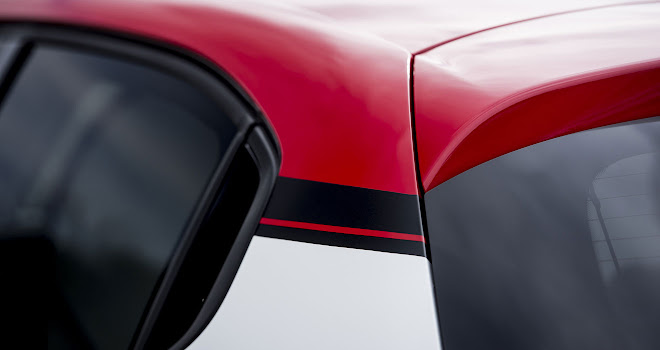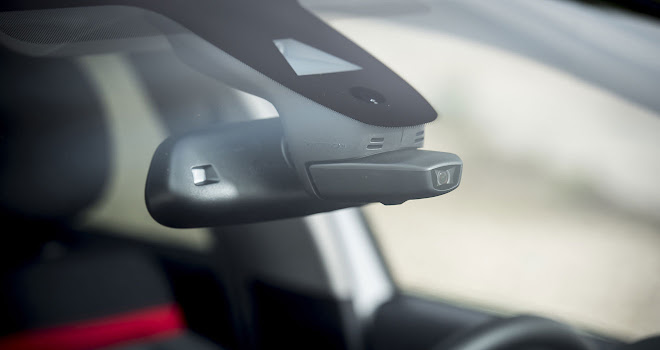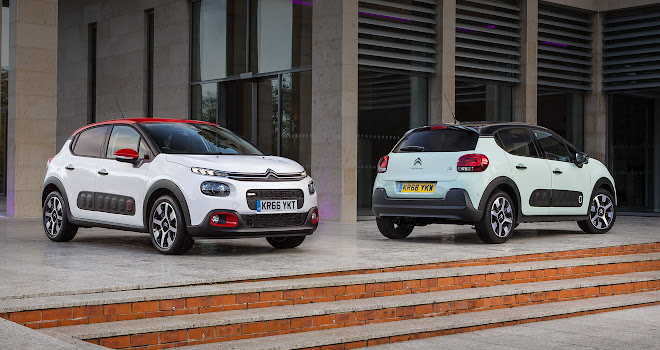
Rating: stars
Good: cute crossover styling, comfortable seats, soothing ride
Bad: noisy when pressed, low-rent plastics, tight rear cabin
Price: from £10,995 – the version tested starts at £15,995
It’s a little surprising that Citroen’s new C3 isn’t called C3 Cactus. There’s a strong family resemblance between the new car and the slightly larger C4 Cactus, which arrived a couple of years ago.
The rounded oblong plastic bumps that protect the Cactus’s vulnerable parts have become a repeated design theme throughout the new C3. The shape can be found indented in the interior door panels of the new car, in the door release, in the chrome-rimmed air vents, popping up unexpectedly in the headlining, and even pressed into the sheet metal of the roof like a giant robot’s footprint.
Oddly, the one place where you’d expect to find this lozenge shape and don’t is in the outline of the C3’s actual Airbumps. The new car’s rubbery protection comes in the form of rounded squares rather than oblongs, presumably just to confound our expectations.

The Airbumps are in any case less of a feature on the C3, toned down and lower down and probably less effective at preventing annoying car-park dings than in the Cactus. The Airbump panels are also optional in the middle of the C3 range, costing £290 along with front foglamps, or you can delete Airbumps from top-spec models at no charge (you don’t get £290 off). Choose not to have them and you’ll find a neat, shallow indentation left behind in the C3’s flanks.
All but the entry-level C3 can be ordered with a contrasting roof at no extra cost – choose from black, white or red – or a panoramic glass roof for £400. There are also nine body paint options to select from. The colour of the roof can be repeated in the fog-lamp surrounds, mirror caps and in a ring around the leading Airbump.

The car’s sheet metal doesn’t include a natural break between roof and body at the rear, so the upper paint job extends a little way down the pillar before meeting a stuck-on decal strip that defines the junction. This arrangement does seem a little arbitrary compared to most other cars that offer a separate roof colour. Perhaps we should admire this illogical quality in a Citroen – the roof junction is a design feature that can only really be justified with a Gallic shrug and a wave of the hand.
Like the Cactus, the C3 projects a crossover vibe, an impression created by a bluff nose and high bonnet line, accentuated by the black plastic cladding that runs all the way around the lower edge of the car and up over the wheelarches. The entry level Touch trim level lacks most of the cladding and looks a bit naked as a result.

Off-road suggestions are purely visual, of course. The C3 employs an ordinary front-wheel-drive supermini layout under the skin, and is not especially high-riding. In fact the new car is 4cm lower than the outgoing, egg-shaped C3. A grip-maximising, electronically controlled front axle – as seen in the Cactus Rip Curl – is not on the new C3’s options list, never mind four-wheel-drive.
Inside, there’s no mistaking that the C3 has been made to a tight budget. There’s plenty of hard, low-rent plastic on the doors and dashboard. However, Citroen has done a fine job lifting the overall ambience with broad, comfortable seats finished in furniture-like fabrics.

As well as neutral grey interior there’s the option of sporty charcoal and red upholstery for £150, while the £380 “Hype Colorado” interior features toffee-coloured leather highlights. I loved the unusual orangey result but I may well be in the minority. I’ve heard other people call it revolting.
Soft grey door pulls that resemble luggage handles, borrowed from the Cactus, are appealing both to the eye and hand, while the horizontal trim panel on the face of the dashboard can be finished in piano black plastic or neatly stitched leatherette. The prevalence of horizontal lines is meant to make the cabin feel wider and more spacious than it actually is, by the way.

The UK-spec glovebox is a little small, partly because the fuse box hasn’t been moved from its left-hand-drive position, and partly because the passenger airbag lives in the dash, as it does in most other cars. I hear that the space-liberating, roof-mounted airbag of the C4 Cactus is unlikely to be repeated in another model, sadly.
The C3 also retains a conventional analogue instrument panel with only a small digital section for information, unlike the Cactus’s all-digital cluster.
Mid-spec and higher models of the C3 feature a central seven-inch touchscreen that supervises almost all functions – there are very few buttons on the C3’s sparse centre console. You have to switch out of satnav mode to change heater settings, for example.

The C3 also offers a built-in dashcam, mounted behind the rear-view mirror. If you wind up in an accident this unit will automatically store 30 seconds before and 60 seconds after the impact, which could prove useful in protecting your no-claims bonus.
The wide-angle camera can also be pressed into service to make videos and take snaps, for social media sharing via a downloadable smartphone app. Oddly, the camera connects to your phone using Wi-Fi rather than Bluetooth and I found this feature swallowed up big chunks of battery power, transforming my phone into an effective pocket warmer. If you like the idea of messing around with the camera, remember to bring a charging cable.

While front-seat passengers will have no complaints, accommodation in the back row is on the tight side – the C3 won’t be setting any new benchmarks in rear headroom or legroom. The boot is reasonable at 300 litres, however, and you can fit a skinny spare wheel under the floor rather than having to rely on a doubtful tin of goo.
Citroen has cooked up a strategy called Advanced Comfort to shape its immediate future, so it’s no surprise to find that the C3’s suspension favours comfort over cornering. The C3 lollops along in a soothing fashion yet retains sufficient composure to maintain confidence on a twisty road. If you want to hare off and clip apexes the C3 will not be your best bet. But if you’d rather float over broken tarmac without waking the baby, the C3 will do its level best.
I found the little Citroen a likeable thing to steer, though the turning circle is not especially tight for city manoeuvring.

I’ve tested only the top-spec Flair trim level, but I did sample both petrol and diesel power. Both can be gruff and growly under acceleration – the petrol engine is surprisingly throaty at low revs – but each will settle down to a quiet background hum at steady speeds.
The PureTech 110 petrol is probably the best of the various engine options on offer. It’s a three-cylinder 1.2-litre turbo unit providing up to 110bhp and 205Nm of torque, sufficient to haul the C3’s roughly one-tonne mass to 62mph in 9.3 seconds. It comes with a 103g/km CO2 rating and, judging from my stint behind the wheel, should reward gentle cross-country driving with better than 50mpg.
The 1.6-litre BlueHDi 100 diesel option provides 99bhp and 245Nm and scores just 95g/km in CO2 terms. Thus equipped the C3 is slightly slower and heavier and, more to the point, £1,100 more expensive than with the 110bhp petrol engine. The PureTech 110 starts at £14,945 versus £16,045 for the BlueHDi 100, both in mid-range Feel trim.

The lowest CO2 result of 92g/km requires the BlueHDi 75 diesel engine, yielding 74bhp, 233Nm and a 0-62mph time of 13.8 seconds. It makes up for this lack of urge by costing as little as £13,295 in entry-level spec.
The above three engines include a fuel-saving stop-start system. There are also a pair of cheaper, lower-power petrol options, both lacking stop-start.
Incidentally, the C3 is the first car in a long time to jilt me at a junction. The engine is supposed to stop promptly when stationary in neutral, and quickly start again when you push the clutch to select first gear. I spotted a gap in traffic, popped the car into first, hit the throttle and... nothing at all happened. A helpful message appeared to tell me that I’d failed to fully depress the clutch. I dutifully pushed the clutch to the floor and the engine happily started. So that’s one to watch out for if, like me, you don’t push the pedals to Citroen’s liking.
That incident aside, the manual gearbox and I got along just fine. The throw is longish and not likely to attract comparisons to any well oiled machines, but it doesn’t feel like a stick poked in a bag of gravel either. My chief complaint was that I kept trying to select a non-existent sixth gear.
All things considered, I found the new C3 a welcome new option in the supermini market. It’s light, very comfortable, much better looking than the forgettable car it replaces, and should prove reasonably economical too.









